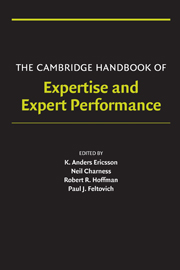Book contents
- Frontmatter
- Contents
- Acknowledgments
- Contributors
- PART I INTRODUCTION AND PERSPECTIVE
- PART II OVERVIEW OF APPROACHES TO THE STUDY OF EXPERTISE – BRIEF HISTORICAL ACCOUNTS OF THEORIES AND METHODS
- PART III METHODS FOR STUDYING THE STRUCTURE OF EXPERTISE
- 8 Observation of Work Practices in Natural Settings
- 9 Methods for Studying the Structure of Expertise: Psychometric Approaches
- 10 Laboratory Methods for Assessing Experts' and Novices' Knowledge
- 11 Task Analysis
- 12 Eliciting and Representing the Knowledge of Experts
- 13 Protocol Analysis and Expert Thought: Concurrent Verbalizations of Thinking during Experts' Performance on Representative Tasks
- 14 Simulation for Performance and Training
- PART IV METHODS FOR STUDYING THE ACQUISITION AND MAINTENANCE OF EXPERTISE
- PART V DOMAINS OF EXPERTISE
- PART VI GENERALIZABLE MECHANISMS MEDIATING EXPERTISE AND GENERAL ISSUES
- Author Index
- Subject Index
- References
13 - Protocol Analysis and Expert Thought: Concurrent Verbalizations of Thinking during Experts' Performance on Representative Tasks
from PART III - METHODS FOR STUDYING THE STRUCTURE OF EXPERTISE
- Frontmatter
- Contents
- Acknowledgments
- Contributors
- PART I INTRODUCTION AND PERSPECTIVE
- PART II OVERVIEW OF APPROACHES TO THE STUDY OF EXPERTISE – BRIEF HISTORICAL ACCOUNTS OF THEORIES AND METHODS
- PART III METHODS FOR STUDYING THE STRUCTURE OF EXPERTISE
- 8 Observation of Work Practices in Natural Settings
- 9 Methods for Studying the Structure of Expertise: Psychometric Approaches
- 10 Laboratory Methods for Assessing Experts' and Novices' Knowledge
- 11 Task Analysis
- 12 Eliciting and Representing the Knowledge of Experts
- 13 Protocol Analysis and Expert Thought: Concurrent Verbalizations of Thinking during Experts' Performance on Representative Tasks
- 14 Simulation for Performance and Training
- PART IV METHODS FOR STUDYING THE ACQUISITION AND MAINTENANCE OF EXPERTISE
- PART V DOMAINS OF EXPERTISE
- PART VI GENERALIZABLE MECHANISMS MEDIATING EXPERTISE AND GENERAL ISSUES
- Author Index
- Subject Index
- References
Summary
The superior skills of experts, such as accomplished musicians and chess masters, can be amazing to most spectators. For example, club-level chess players are often puzzled by the chess moves of grandmasters and world champions. Similarly, many recreational athletes find it inconceivable that most other adults – regardless of the amount or type of training – have the potential ever to reach the performance levels of international competitors. Especially puzzling to philosophers and scientists has been the question of the extent to which expertise requires innate gifts versus specialized acquired skills and abilities.
One of the most widely used and simplest methods of gathering data on exceptional performance is to interview the experts themselves. But are experts always capable of describing their thoughts, their behaviors, and their strategies in a manner that would allow less-skilled individuals to understand how the experts do what they do, and perhaps also understand how they might reach expert level through appropriate training? To date, there has been considerable controversy over the extent to which experts are capable of explaining the nature and structure of their exceptional performance. Some pioneering scientists, such as Binet (1893/1966), questioned the validity of the experts' descriptions when they found that some experts gave reports inconsistent with those of other experts. To make matters worse, in those rare cases that allowed verification of the strategy by observing the performance, discrepancies were found between the reported strategies and the observations (Watson, 1913).
Information
- Type
- Chapter
- Information
- The Cambridge Handbook of Expertise and Expert Performance , pp. 223 - 242Publisher: Cambridge University PressPrint publication year: 2006
References
Accessibility standard: Unknown
- 214
- Cited by
